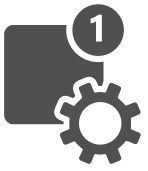UBIK Push Web Service
A normal data web service (Content Service) delivers data when it is asked for it. In contrast the Push Service is responsible for pushing data to every client.
The push service acts as a central data hub and has a set of methods to get the update information, containing the data that must be pushed to the client defined by its criteria, by the sequence and by the last known status.
The push service is aware of known devices and users and delivers the situation relevant update information. The service is capable of persisting the update data in the UBIK® system as the push service must deliver the correct data for every client.
Contents
Push Triggers
The service supports following update triggers:
- Force update of single Content
- Force update of children of Content
- Force removing of single Content
- Force update of Infrastructure
- Force update of Root objects
- Force update of Metadefinitions
Push Criteria
The service supports following criteria:
| Name | Purpose |
|---|---|
| Sequential | If set, data will be pushed only once |
| Device dependent | Filter on a Satellite object |
| User dependent | Filter on a Login object |
| Application name | Filter on an Application object |
| Context name | Filter on a Context object |
| Location dependent | (future version) |
Configuration
Service
The UBIK® Push Service is available since Version 2.3.1. As the Push Service uses the same configuration as the UBIK® Content service it is recommended to configure the push service in the same folder as UBIKContent.svc.
The File UBIKPush.svc contains the basic definition of the service:
Endpoint
The Endpoint of the push service must be configured in the service section of the Services.Config file:
...
<service name="UBIK.Service.UBIKPush" behaviorConfiguration="httpBehavior">
<endpoint address="" behaviorConfiguration="httpBehavior" binding="webHttpBinding" contract="UBIK.Service.IUBIKPush" />
<endpoint address="/SOAP" binding="wsHttpBinding" contract="UBIK.Service.IUBIKPush" />
</service>
</services>
Web Service Interface
The most important web service members are listed here, where more detailed information and a comprehensive list of all members and data types are located in the UBIK® class documentation.
AddUpdateInformation
The web service provides a method to add content to be pushed to the clients:
/// AddUpdateInformation provides the possibility to register data to be forwarded (pushed) to the clients
/// </summary>
/// <param name="data">Data which should be pushed to the clients, and criteria which must be fullfilled for pushing</param>
/// <returns>true as adding the information was successfull</returns>
[OperationContract]
[WebInvoke(UriTemplate = "AddUpdateInformation", Method = "POST",
RequestFormat = WebMessageFormat.Json,
BodyStyle = WebMessageBodyStyle.Bare,
ResponseFormat = WebMessageFormat.Json)]
bool AddUpdateInformation(PushUpdateDefinition data);
DebugInfo
The push web service provides access to its current status via a debug - info method. Use this to retrieve information about the current status of the web service. This method can also be called via a web browswer by browsing the according URL.
/// Delivers info about the current status of the Push Service.
/// </summary>
/// <param name="token">authentication token</param>
[OperationContract]
[WebInvoke(UriTemplate = "DebugInfo/{token}", Method = "GET",
RequestFormat = WebMessageFormat.Json,
ResponseFormat = WebMessageFormat.Json)]
string DebugInfo(string token);
Reset
To trigger reinitialization (reset) of the push web service from extern, call this method via a web browser.
/// Resets the Cache of the Push Service
/// </summary>
/// <param name="token">authentication token</param>
[OperationContract]
[WebInvoke(UriTemplate = "Reset/{token}", Method = "GET",
RequestFormat = WebMessageFormat.Json,
ResponseFormat = WebMessageFormat.Json)]
void Reset(string token);
Future Prospective
Currently there is no UI implementation for the push web service. To guarantee an optimal integration of the push service to the UBIK® Kernel a socket implementation of the push service is provided via the environment. This socket class uses the web service methods to add data to the push service. The configuration of the web service must be done as it is done for the LAS/GAS. An instance of this socket class is provided via the UBIK® environment.

